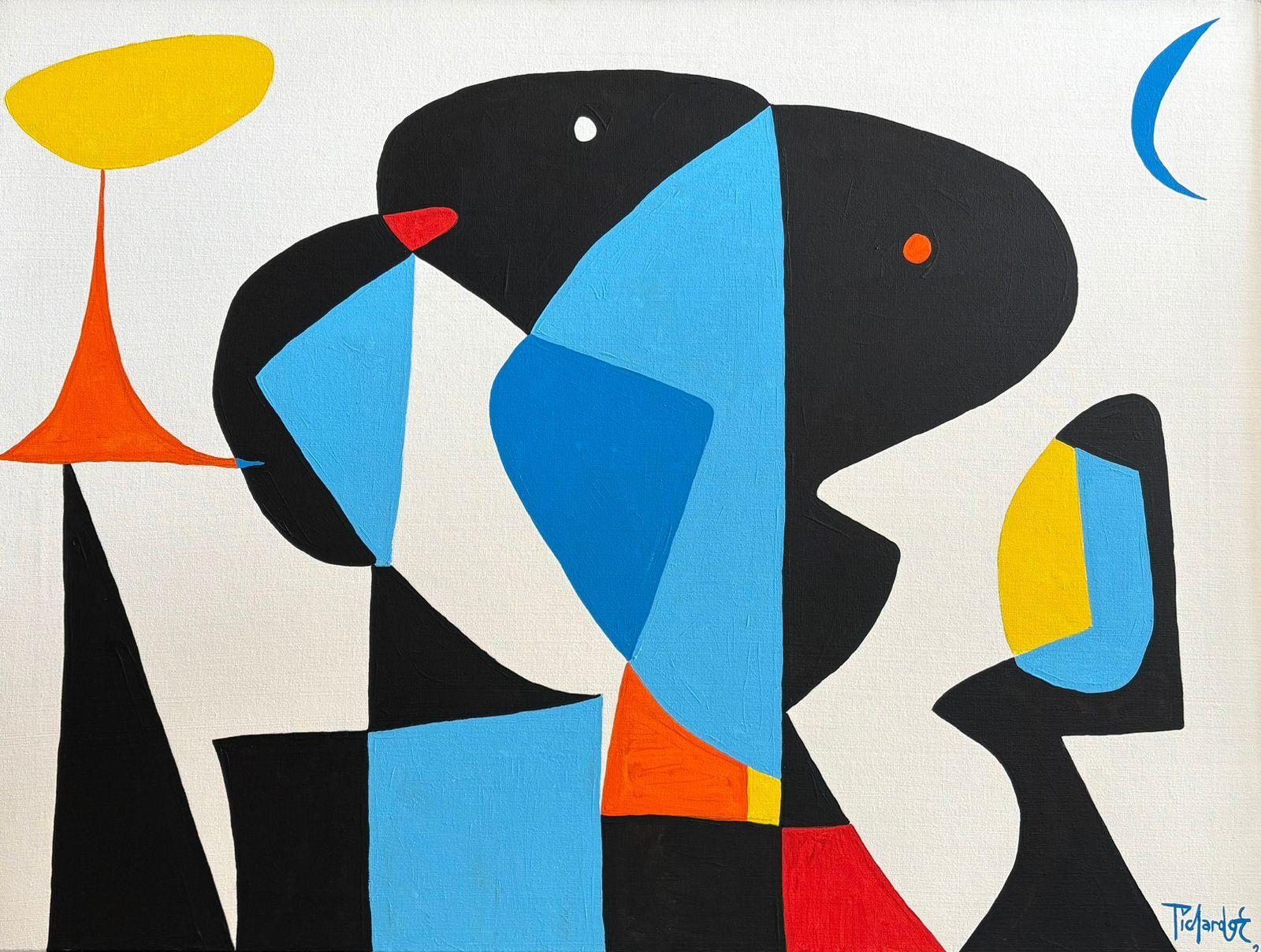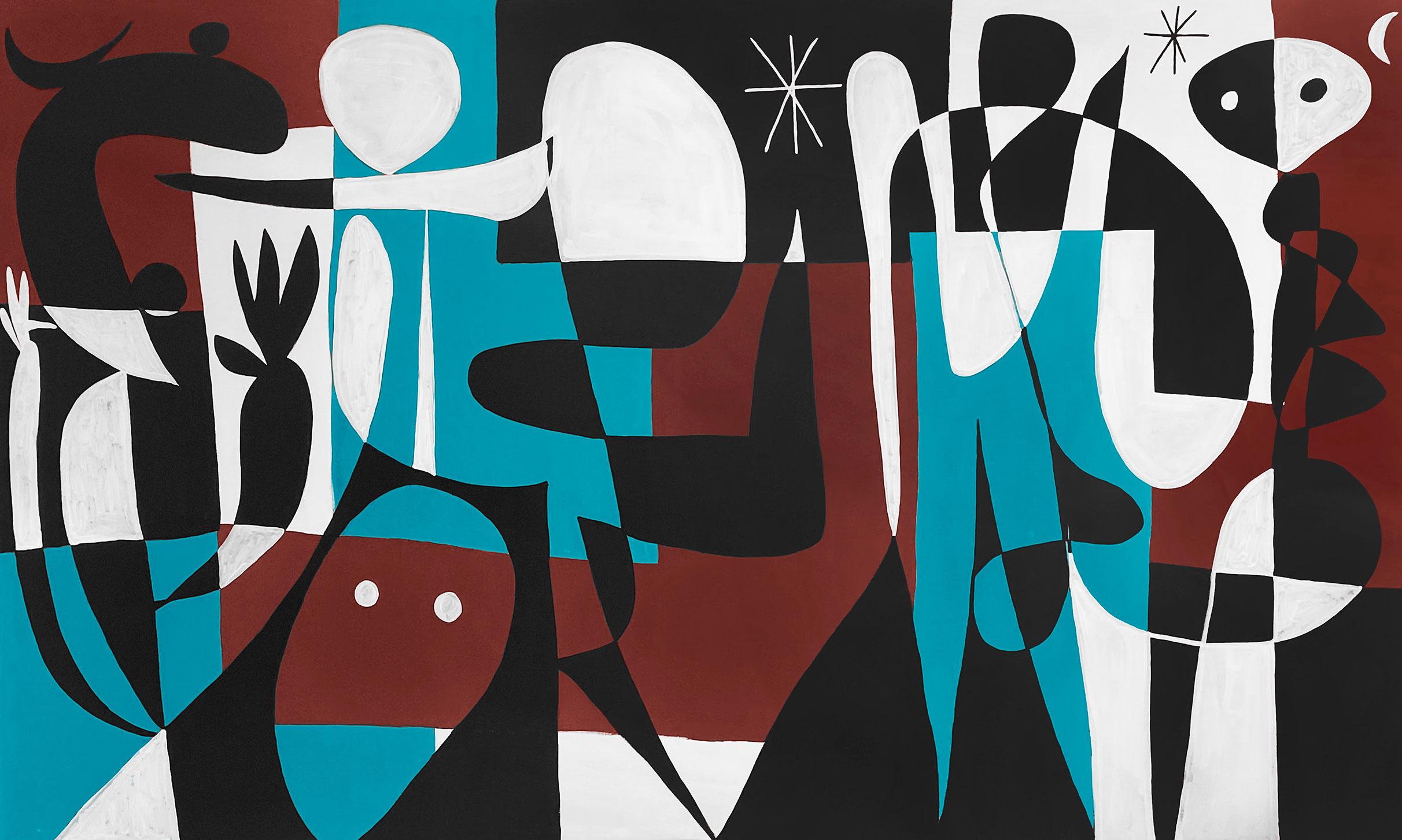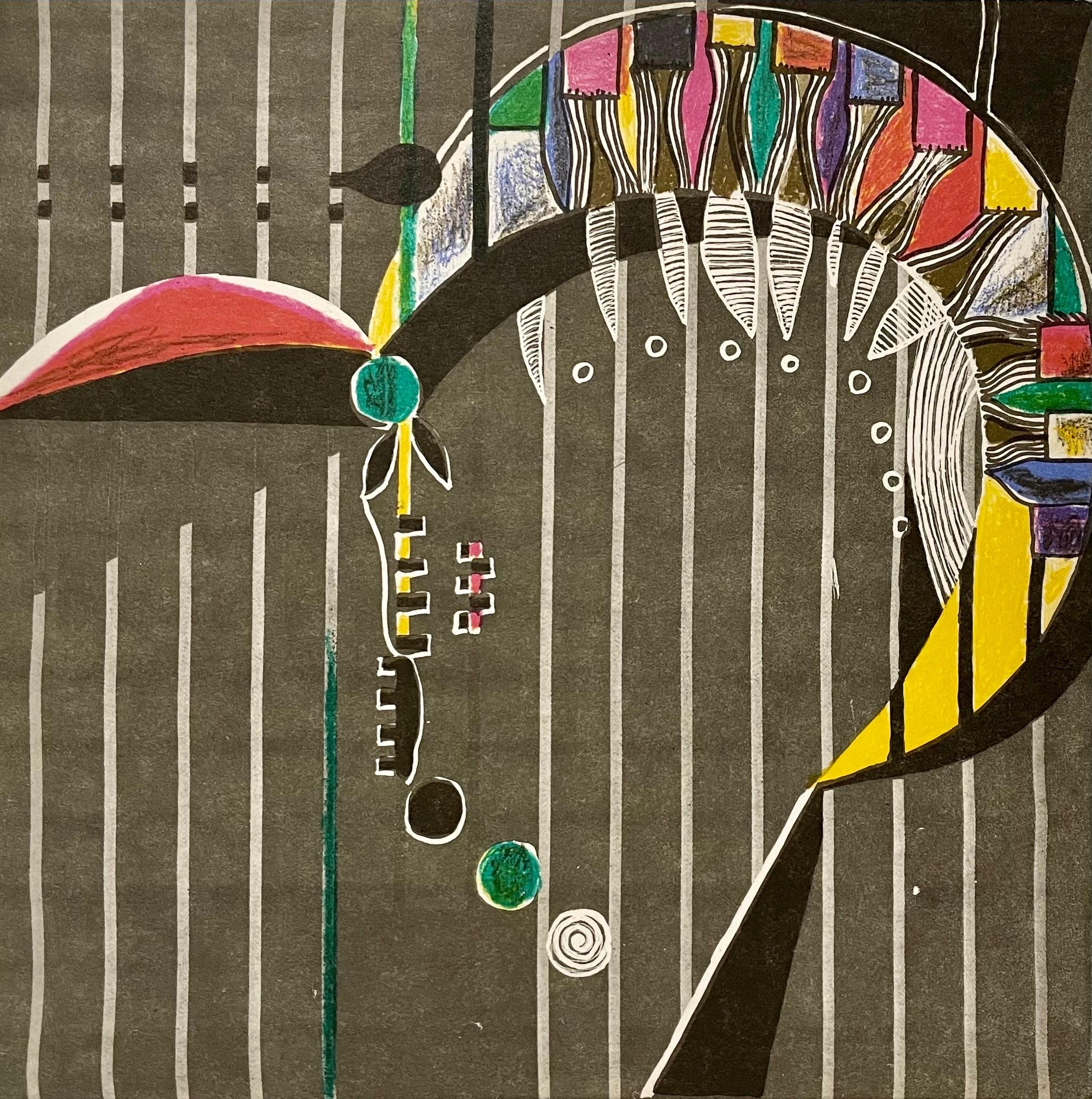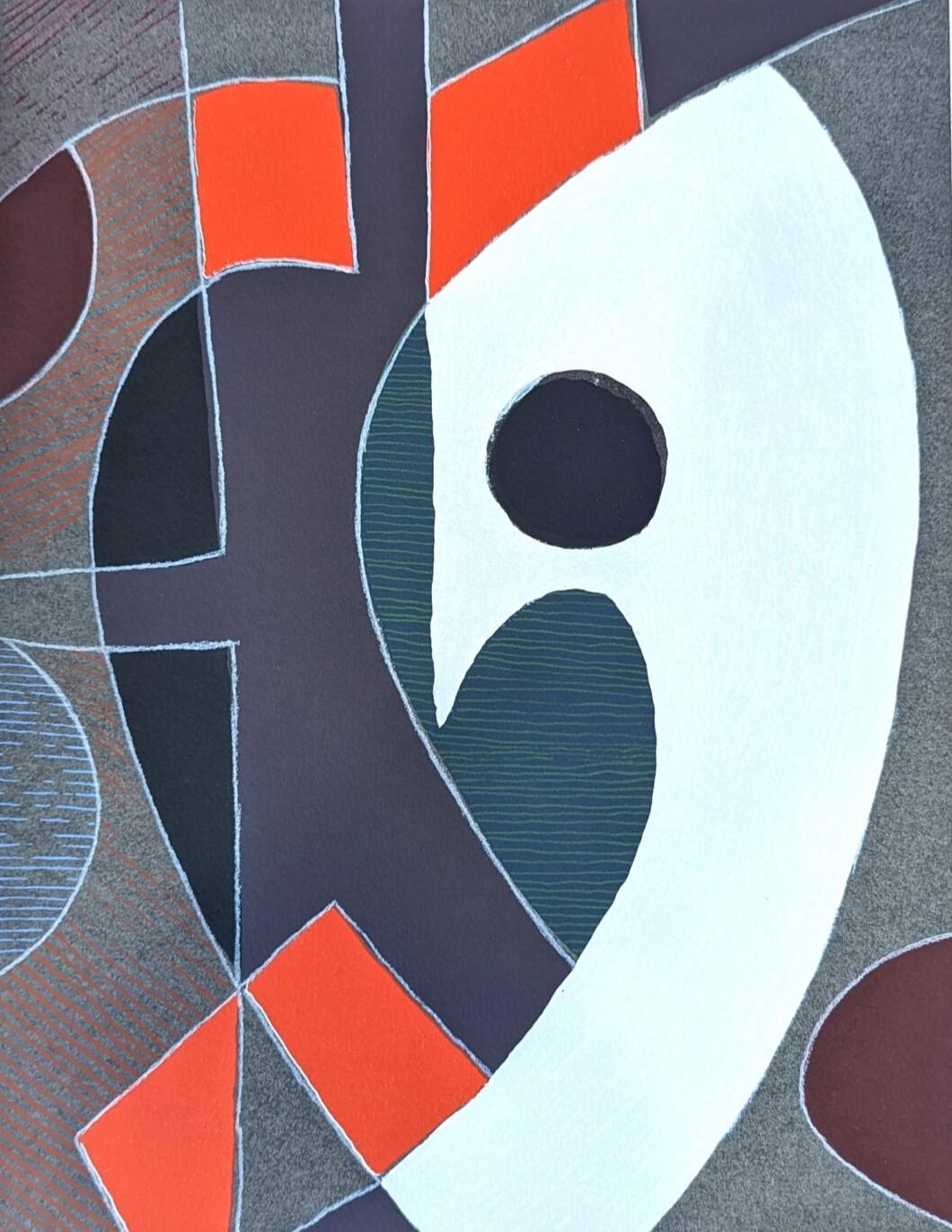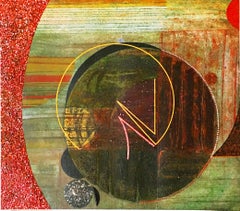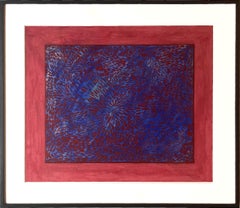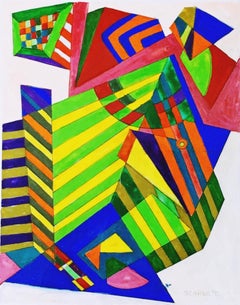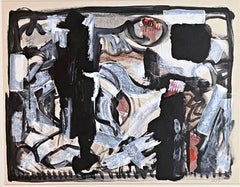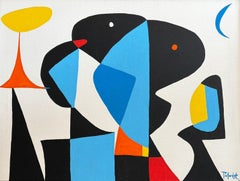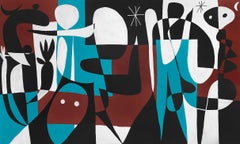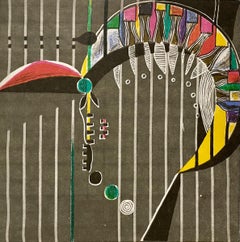Items Similar to Mirage (ex Reader's Digest Art Collection) Op Art Surreal renowned female artist
Want more images or videos?
Request additional images or videos from the seller
1 of 15
Edna AndradeMirage (ex Reader's Digest Art Collection) Op Art Surreal renowned female artist1988
1988
$18,000
£13,672.47
€15,755.32
CA$25,348.46
A$28,102.51
CHF 14,768.97
MX$343,928.68
NOK 184,449.39
SEK 173,124.21
DKK 117,603.69
About the Item
Edna Andrade
Mirage (de-accessioned from the Reader's Digest Art Collection), 1988
Original Collage painting on board
Signed, titled & dated on the front; the back bears labels from Marian Locks Gallery & Readers Digest Association with inventory (RDA) number
Original frame included with collection and gallery labels verso
This is a unique work
Exquisite 1980s collage on board painting (framed) titled "Mirage" by renowned female Op artist Edna Andrade, whose market has seen a big resurgence of late. Verso bears labels from Marian Locks Gallery. De-accessioned from the prestigious Readers Digest Association Art Collection with corporate inventory (RDA) number.
Edna Andrade Biography, courtesy of Locks Gallery: One of the foremost artists to emerge in Philadelphia in the 1960s, Edna Andrade (1917-2008) is now recognized as an early leader in the Op Art movement. Characterized by pulsating patterns, vivid colors, and a visual immediacy that surpasses narrative meaning, her work explores symmetry and rhythm through geometric design and structures inspired by nature. The new 176-page monograph, Edna Andrade, takes a comprehensive look at the full range of Andrade's work, from her early surreal and figurative landscapes, through several decades of Bauhaus-inspired design and the distinctive geometric patterns of Op Art, to her late-life quasi-abstract studies of the Atlantic coastline. Accompanied by 170 illustrations, including full-color reproductions as well as photographs, drawings, sketches, and notes, the essays situate Andrade's work in the context of movements that surfaced in the United States in the 1960s, such as Minimalism and Pop Art. The first book-length study of her career as an artist and teacher, Edna Andrade examines the aesthetic influences, creative development, and enduring legacy of this dynamic twentieth-century artist.
Measurements:
Framed:
18.5 x 21.25 x 1 inches
Artwork:
9 x 11 inches
- Creator:Edna Andrade (1917 - 2008, American)
- Creation Year:1988
- Dimensions:Height: 18.5 in (46.99 cm)Width: 21.25 in (53.98 cm)Depth: 1 in (2.54 cm)
- Medium:
- Movement & Style:
- Period:
- Condition:
- Gallery Location:New York, NY
- Reference Number:1stDibs: LU1745212944702
About the Seller
5.0
Platinum Seller
Premium sellers with a 4.7+ rating and 24-hour response times
Established in 2007
1stDibs seller since 2022
450 sales on 1stDibs
Typical response time: 2 hours
- ShippingRetrieving quote...Shipping from: New York, NY
- Return Policy
Authenticity Guarantee
In the unlikely event there’s an issue with an item’s authenticity, contact us within 1 year for a full refund. DetailsMoney-Back Guarantee
If your item is not as described, is damaged in transit, or does not arrive, contact us within 7 days for a full refund. Details24-Hour Cancellation
You have a 24-hour grace period in which to reconsider your purchase, with no questions asked.Vetted Professional Sellers
Our world-class sellers must adhere to strict standards for service and quality, maintaining the integrity of our listings.Price-Match Guarantee
If you find that a seller listed the same item for a lower price elsewhere, we’ll match it.Trusted Global Delivery
Our best-in-class carrier network provides specialized shipping options worldwide, including custom delivery.More From This Seller
View AllFree More, original Zabriskie Gallery & Reader's Digest Collection labels signed
By Pat Adams
Located in New York, NY
Pat Adams
Free More, 1989
Acrylic and encaustic painting with varnish on paper laid down on canvas
Hand signed and dated on the upper left front
Original artist's frame included
This...
Category
1980s Abstract Abstract Paintings
Materials
Mixed Media, Graphite, Pencil, Acrylic, Encaustic, Varnish
Near and Far Acuity, Signed Mid Century Modern Op Art painting, historic exhibit
By Richard Anuszkiewicz
Located in New York, NY
Richard Anuszkiewicz
Near and Far Acuity, 1957
Gouache and watercolor painting on board
Hand signed and dated 1957 by Richard Anuszkiewicz on the right front
Frame included
Anuszkie...
Category
Mid-20th Century Op Art Abstract Drawings and Watercolors
Materials
Mixed Media, Watercolor, Gouache
Untitled Mid-Century Modern Geometric Abstraction
By Rolph Scarlett
Located in New York, NY
Rolph Scarlett
Untitled Mid-Century Modern Geometric Abstraction, ca. 1950
Gouache on paper painting
Hand signed on lower right front
This is a stunning original, signed vintage 1950...
Category
Mid-20th Century Abstract Geometric Abstract Paintings
Materials
Gouache, Mixed Media, Pencil
Mid century Modern 1960s Abstract Expressionist painting, renowned artist Signed
Located in New York, NY
Jack Wolfe
Untitled, 1965
Acrylic and collage on board
Hand signed on the front
Frame included: held in original vintage frame with original gallery label
Unique
Provenance: Parker Street 470 Gallery, Boston, Mass (with label verso)
Excellent abstract expressionist mixed media work.
Measurements:
Image:
17" x 24"
Framed:
24" x 28" x 1"
From Wiki:
Jack Wolfe (14 January 1924 – 18 November 2007) was a 20th-century American painter most known for his abstract art, portraiture, and political paintings. Jack Wolfe was born in Omaha, Nebraska on January 14, 1924, to Blanche and Everett L. Wolfe. Soon after his birth, his family moved to Brockton, MA. At 18, Wolfe had an interest in commercial illustration, which he pursued at the Rhode Island School of Design (RISD). However, upon matriculating at RISD in 1942, he developed an interest in fine art and painting inspired by an exhibition of modern French art. He described this change of direction, explaining that, "One day, for the first time, I saw an exhibition of modern French art. It was like being struck by lightning." He became particularly interested in the work of a number of European modernists, including Rouault, Cézanne, Braque, Modigliani, and Picasso.[1] Following his time at RISD, he pursued a Master’s in Fine Arts degree at the Museum of Fine Arts School in Boston, MA. At the Museum School, Wolfe studied under the renowned Expressionist Karl Zerbe, a German-born artist who was the Museum School's most influential and vital teacher until 1953.[2] After graduating from the Museum School, Wolfe was represented by the Margaret Brown Gallery in Boston, which also represented many other cutting edge Moderns that defied the more conservative tastes of New England collectors at the time, including György Kepes, Congur Metcalf, and Alexander Calder.[3]
Career and Museum Representation
Jack Wolfe's painting "Robin's Rock" 1962, 72" x 72"
Jack Wolfe's artwork received early recognition from a number of organizations and was consistently featured in influential exhibitions, including the 1955 Carnegie International at the Carnegie Institute in Pittsburgh, PA, the American Federation of Art's traveling exhibition New Talent in the USA in 1956-57, the Whitney Museum’s Young America exhibition in 1957,[4] the Boston Institute of Contemporary Art's Selection exhibition in 1957,[5] and both the Whitney Museum’s 1958 Annual exhibition and its Forty Artists Under Forty show in 1962-63.[6] In 1959, his widely acclaimed Portrait of Abraham Lincoln toured Europe in a show circulated by the Institute of Contemporary Art, Boston. In addition, his painting Crucifixion was chosen by the United States Information Agency to be exhibited across Europe, including being shown at the Salzburg Biennial in Austria in 1958.[7] Crucifixion was also exhibited at the Whitney Museum and subsequently displayed in the National Cathedral in Washington, DC, in 1958.[8] In 1966-67, his work was selected for Art for Embassies by the U.S. State Department.[9] He received the first annual Margaret Brown Memorial Award for high achievement by a New England Artist from the Institute of Contemporary Art, Boston, in 1958.[10]
With his future as one of the great artists of his time laid out neatly before him, Wolfe moved to New York in the early 1950s, which was then the postwar epicenter of the art world and in the midst of experiencing the first real revolution in American Art, now known as Abstract Expressionism.[11] However, almost immediately upon his arrival, he became disenfranchised with the overtly commercial nature of the art scene there, spurning fame and security in an unwillingness to bend his creative vision to the expectations of others.[12] After four short months, he left New York, returned to Massachusetts where he bought property in Stoughton, cleared the land, and built both his home and studio with his own two hands. He would go on to live and paint there, extensively exhibiting and garnering constant critical acclaim.[13]
Wolfe became one of the earliest artists championed by the deCordova Museum in Lincoln, MA and the Institute of Contemporary Art in Boston. He was awarded a traveling scholarship in 1958,[6] which allowed him to set up studio in San Miguel de Allende, Mexico and then in San Francisco, California.[14] Upon his return in 1959, the deCordova museum hosted Wolfe’s third solo exhibition, featuring work made during his time in California...
Category
1960s Abstract Expressionist Abstract Paintings
Materials
Mixed Media, Acrylic, Gouache, Permanent Marker
Untitled mid century modern geometric abstraction
By William Fredericksen
Located in New York, NY
William Fredericksen
Untitled mid century modern geometric abstraction, 1958-1959
Watercolor and Gouache on Board
Hand signed and dated on the front
12 4/5 × 11 7/10 inches
Unframed
...
Category
Mid-20th Century Abstract Geometric Abstract Drawings and Watercolors
Materials
Mixed Media, Watercolor, Gouache
Unique signed Mid Century Modern Abstract painting by renowned American painter
By Thomas Brownell Eldred
Located in New York, NY
THOMAS BROWNELL ELDRED
Untitled Mid Century Modern Abstraction, 1941
Gouache on paper
Hand signed and dated 1941 on the front
14 3/4 × 21 inches
Unique
Provenance: Acquired from the estate of Thomas Brownell Eldred
Accompanied by Certificate of Guarantee from Alpha 137 Gallery
Unframed
This gorgeously colored gouache painting on thick paper was created at a time when the Guggenheim Museum (Museum of Non-Objective Painting) was collecting Eldred's work, alongside works by Kandinsky and Bauer. Unique works like this by Eldred are very desirable in the marketplace. It typifies the artist's eclectic style, reflecting his involvement with Surrealism and the New York School. It also highlights Eldred’s excellent draftsmanship through the characteristic bright colors and patterns that he developed during his time as a naval wood pattern maker in the merchant marines...
Category
Mid-20th Century Modern Abstract Paintings
Materials
Watercolor, Gouache
You May Also Like
Surreal Abstract Mid 20th Century American Modern Woman Artist Work on Paper
Located in New York, NY
Surreal Abstract Mid 20th Century American Modern Woman Artist Work on Paper
Juanita Guccione (1904 - 1999)
Surreal Abstract
18 x 11 3/4 inches
Watercolor and mixed media on paper
Signed lower left
Framed: 23 x 17 inches
Note. We are currently have listed a 1935 oil by Guccione, and in addition to this abstract drawing, we have several other works on paper, along with a major surrealist oil, none of which are currently listed. Inquiries are invited.
BIO
The following is from Djelloul (Del) Marbrook, son of the artist. Of signatures on paintings by his mother, Juanita first signed as Anita Rice, then as Juanita Rice, Juanita Rice Marbrook, Juanita Marbrook, and finally Juanita Guccione after marrying in the 1940s.
Juanita Guccione's life (June 20, 1904-December 18, 1999) spanned all but four years of the 20th Century. Cubist*, realist, surrealist*, automatist* and abstract strains are all to be found in her work, but by 1970 she was painting works in watercolor and acrylic that no longer included the human figure or the observed world. She was the younger sister of the abstract geometric* artist Irene Rice Pereira. The sisters were born in Chelsea, MA, but spent most of their working lives in Manhattan.
In the early 1930s, Guccione, then painting as Nita Rice, lived for four years among the Ouled Nail...
Category
1940s Abstract Abstract Drawings and Watercolors
Materials
Watercolor, Gouache, Rag Paper
Composición, Contemporary Art, Abstract Painting, 21st Century
By Enrique Pichardo
Located in Mexico City, MX
Contemporary Art, Abstract Painting
Acrylic on canvas / Framed
63 x 83 cm
Signed
About the artist
Enrique Pichardo (Mexico City, 1973) graduated from Escuela Nacional de Pintura, E...
Category
2010s Abstract Abstract Paintings
Materials
Canvas, Acrylic
Desierto, Contemporary Art, Abstract Painting, 21st Century
By Enrique Pichardo
Located in Mexico City, MX
Contemporary Art, Abstract Painting
Acrylic on canvas
205x334cm
Signed
FREE SHIPPING ROLLED UP
About the artist
Enrique Pichardo (Mexico City, 1973) graduated from Escuela Nacional de Pintura, Escultura y Grabado (ENPEG) “La Esmeralda”. As a Mexican Contemporary Expressionism artist...
Category
2010s Abstract Abstract Paintings
Materials
Canvas, Acrylic
$8,000 Sale Price
20% Off
Feminist Surrealist French Abstract Colorful Lithograph Print Myriam Bat Yosef
Located in Surfside, FL
Myriam Bat-Yosef
Surrealist abstract lithograph print in colorful abstract shapes and shades
Hand signed and dated 1971.
sheet measures 9.25 X 9.25 inches
The envelope and the Peter Buch poster is just for provenance and is not included in this sale.
Myriam Bat-Yosef, whose real name is Marion Hellerman, born on January 31, 1931 in Berlin, Germany to a Jewish family from Lithuania, she is an Israeli-Icelandic artist who paints on papers, paintings, fabrics, objects and human beings for performances. Myriam Bat-Yosef currently lives and works in Paris. In 1933, her family fleeing the Nazi Holocaust, Miriam Bat-Yosef emigrates to Palestine and settles in Jaffa. In 1936, she suffers a family tragedy, her father, militant Zionist, is called to fight, still recovering from an operation of appendicitis. The incision will become infected, antibiotics did not exist yet, and her father will die in the hospital after 9 months of suffering.
Myriam and her mother leave Palestine to live in Paris for three years. French is Myriam's first school language. In 1939, still fleeing Nazism, she returned to Palestine, leaving France by the last boat from Marseille. She moved to Tel Aviv with her mother, aunt and maternal grandmother.
In 1940, she began attending the Academy of Fine Arts in Tel Aviv and took her name as an artist, Bat-Yosef, which means Joseph's daughter in Hebrew, as a tribute to her father. In 1946, Myriam graduated as a kindergarten teacher but wanted to be an artist. Her mother enrolled her in an evening school to prepare a diploma of art teacher. At 19, she performs two years of military service in Israel.
In 1952, with a pension of $50 a month that her mother allocated, she went to study at the Beaux-Arts in Paris. To survive, she has several activities while studying. In 1955, she had her first solo exhibition, at the Israeli Club on Wagram Avenue in Paris. Many artists, such as Yaacov Agam, Yehuda Neiman Avigdor Arikha, Raffi Kaiser, Dani Karavan and sculptors Achiam and Shlomo Selinger attended the opening .
In 1956, she enrolled at the School of Fine Arts in Florence. This is where she meets the painter Errô. They share an icy studio in winter. Myriam moves to Milan with friends. She organizes a joint exhibition with Erro, one room each, at the Montenapoleone gallery. Her works are admired by the sculptor Marino Marini and the painters Renato Birolli and Enrico Prampolini. Myriam and Erro exhibit in Rome, Milan, Florence and meet many personalities: Alain Jouffroy and his wife, the painter Manina, Roberto Matta and his wife Malitte, textile artist who was one of the founders of the Pompidou Center. Back in Paris, Myriam and Erro get married, which allows Myriam to avoid being called into the Israeli army during the Suez Canal War.
In 1957, Myriam and her husband went to Iceland. Myriam works in a chocolate factory. Having enough money, she starts producing art again. She exhibited in Reykjavik's first art gallery. She meets the artist Sigridur Bjornsdottir, married to the Swiss painter Dieter Roth .
In 1958, Myriam and her husband leave for Israel. They exhibit in Germany, then in Israel. Back in Paris, the couple became friends with artists of the surrealist movement, such as Victor Brauner, Hans Bellmer, the sculptor Philippe Hiquily, Liliane Lijn, future wife of Takis and photographer Nathalie Waag. Erro and Myriam have a daughter on March 15, 1960, named Tura, after the painter Cosmè Tura, but also close to the Icelandic Thora or the Hebrew Torah. Bat-Yosef’s complex trajectory throughout the 20th century is linked as much to the transnational history of what was for a time called the School of Paris as it is to a certain legacy of Surrealism. Her work features the same idea of resolving antinomies that also defined the spirit of surrealism, and is enhanced with her readings of the Kabbalah and her spiritual grounding in Taoism. However, while there are reasons for her approach to be associated with the process of the ready-made, it is important to consider the immediate intrication of these works with her practice of performance, during which the body itself is also painted – a feminist response to Yves Klein’s Anthropometries (1960) and an echo of the happenings which Jean-Jacques Lebel organised at the time in Paris.
In 1963, Erró told Myriam that if she wants to be a painter, she can not be his wife. Myriam chose to be a painter and the couple divorced in 1964. Since that time, Myriam Bat-Yosef has exhibited in many countries: Europe, United States, Japan, etc.
Although long in the shadows, the work of Myriam Bat-Yosef has been greeted by many artists and personalities: Anaïs Nin, Nancy Huston, André Pieyre of Mandiargues, José Pierre, René de Solier , Jacques Lacarrière, Alain Bosquet, Pierre Restany, Sarane Alexandrian and Surrealist André Breton who, after a visit to her studio, confided to having been intrigued by its phantasmagorical dimension. She was included in the book Pop Art and Beyond: Gender, Race, and Class in the Global Sixties by Mona Hadler and Kalliopi Minioudaki. Extract "World Citizen, Artist of the Pop Era Sarah Wilson; Why do we know so little of Myriam Bat-Yosef, the most important female Israeli artist of the Pop era? Issues of identity and sexuality feature constantly in her work. She exhibited internationally from Reykjavik to Tokyo; she had two shows at Arturo Schwarz’s famous Dada/surrealist gallery in Milan; she participated in feminist art events in Los Angeles. Above all, in 1971, she conceived Total Art, a Pop Gesamtkunstwerk inside and outside the Israel Museum, Jerusalem. Painter, performer, and installation artist, she was also a lover, wife, and mother. Of Lithuanian-Jewish descent, she was close to the family of philosopher Emmanuel Levinas. An émigré in Paris she would repudiate a national passport, participating in Garry Davis’s short-lived “World Citizens” movement. She continues the lineage of women surrealist artists: Valentine Hugo, Leonor Fini, Dorothea Tanning, Leonora Carrington, Unica Zürn, Jane Graverol, Toyen, Alice Rahon...
Category
1970s Surrealist Abstract Prints
Materials
Lithograph
20th Century Abstract Signed Lithograph by Mary Anne Rose - Colour Composition
Located in Bristol, GB
COLOUR COMPOSITION
Sheet size: 38 x 30 cm
Image size: 31 x 23.5 cm
Lithograph on paper
A 20th century limited edition (111/230) coloured lithograph by Mary Anne Rose.
It is signed ...
Category
20th Century Abstract Abstract Prints
Materials
Lithograph
Syncopated World
Located in New York, NY
acrylic on panel
Category
2010s Contemporary Abstract Paintings
Materials
Acrylic, Panel
More Ways To Browse
Op Art Artist
Female Surrealists Art
1960s Op Art
1960s Surreal Art
Artist Edna Andrade
Wire Man
Israeli Pop Art
Heart Vanity
Acrylic Fish
Nevada Painting
Paul Klee Signed
Studio 54 Art
French Painting Vertical
Hunting Light
Retro New Orleans Art
Pink Botanical Art
Robert Grace
Unknown Abstract Expressionist Painting
